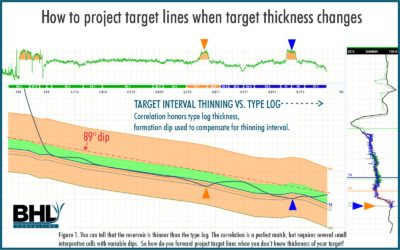Try this: ask your drilling engineer and/or manager to run 30’ surveys in the next well. What kind of response will you get? Laughter? Eye rolls? Flat out “No”?
90’ survey data is industry-standard beyond the end of the curve (EOC). But what is lost between the survey points?
Before we get to the answer here is a disclaimer. We’re not advocating that everyone take 30‘ surveys in every well. Just want you to consider the impact of survey spacing and make informed decisions. Every well is unique. We get that. And of course, we want you to understand the inherent uncertainties. Okay, moving on…
The answer to the question about what is lost between survey points is accuracy. Accuracy of two fundamental quantities: well path Inclination (INC) and TVD values. These two can be significantly degraded simply by dropping back to 90’ survey spacing (Real well example discussed below!!). Any “slop” in INC or TVD will manifest itself in false formation dip and formation TVD.
For now, we’re focusing on how survey spacing impacts wellbore INC and therefore, formation dip. Next post, we will discuss how it impacts apparent TVD of wellbore and therefore, formation TVD.
Quick acknowledgement that 90’ survey data is actually collected approximately every 90’-96’, and 30’ data is actually collected every 30’-33’. Inclination at every point between surveys is interpolated. For simplicity, we’re referring to 90-foot and 30-foot survey spacing here.
In the early days of horizontal drilling, 30’ surveys were much more common. Perhaps operators were investing for the sake of learning or perhaps for the sake of accuracy? But nowadays operators face increasingly skimpy well economics. Surveys consume rig time. Rig time is expensive.
How do 30’ data and 90’ data from the same well compare?
In order to test and demonstrate the impact of survey spacing, we took 30’ data from wells drilled back in the day (you know, from ~2006-2010) and plotted them using all survey points. Then we took the same wells and simply deleted all but every third survey from EOC to TD, thereby replicating 90’ spacing in the laterals. The differences were significant and occasionally alarming.
Example well “A”
Originally drilled w/ 30’ surveys, the well is shown as it was originally surveyed and plotted in black, the dots showing the actual survey points. The blue wellbore plot uses only every 3rd survey (+/- 90’) beyond EOC. There is a lot of vertical exaggeration here to show important details.
Pay special attention to where the well path appears to “roll over” (the up-down/ down-up inflection points). Lateral displacement of these inflections are highlighted with red arrows between the 30’ and 90’ wellbore plots. Notice that a few of these inflections are displaced well over 100’ laterally. You may also notice discrepancies in apparent TVD depth between the well paths. We’ll discuss that in the next post.
Why does matter if inflection points are shifted between 90’ and 30’ data?
Formation dip is based on the angle of incidence between the well path INC and formation bedding. So, if INC is skewed (for example) by 1.5 degrees then apparent DIP will also be skewed by 1.5 degrees, either up or down. In other words, any error or exaggeration in INC will be equally manifested in apparent formation dip. This is shown diagrammatically in the four snapshots at the base of the main image.
This phenomenon frequently goes unnoticed. It’s impact on apparent dip is unavoidable unless the interpreter simply makes an assumption, ignores a mismatch between his-her MWD data and the type log in favor of a formation dip that fits a pre-determined structural model. Hopefully, the assumption is a good one.
Don’t image logs and continuous-inclination surveys eliminate this problem?
Image logs are 100% subject to these same effects, so not so much… No matter how precise they might appear, image logs are still entirely dependent upon accurate wellbore position. In addition to skewed formation dip values, it is well known that image logs can produce significantly incorrect reservoir thickness values unless the wellbore position is accurately rendered.
Continuous-INC survey tools and data can help quite a lot. However, they are considerably more expensive that convention “stationary survey” tools & methods. Consequently, we don’t so often have the luxury of continuous-INC data. Several interesting papers have been published on these tools, so we might come back to these in a later post. Be sure to put in your requests.
What about seismic data? Can it help?
Of course, properly shot, processed and interpreted seismic helps, but ask any honest geophysicist about the depth resolution of his best 3-D data at, let’s say, 10,000’ depth. The answer is usually somewhere in the range of 50’, assuming good data, good processing, good velocity control, good reflectors, and smart interpretation. Formation dip being inextricably related to depth, faces similar limits of accuracy. (Geophysicists: we need you and love you, but somebody had to say it.)
Takeaways for anyone who has to live with a geosteering interpretation
- Geologic structure and reservoir geometry in a geosteering interpretation are 100% based upon well path position. “Garbage-In: Garbage-Out” always applies.
- Wellbore position and formation dip are usually more accurate with closer-spaced surveys. Here, we’ve compared 30’ and 90’ surveys. Something similar would appear if we compared 10’ surveys to 30’ surveys… Anybody have 10’ survey data?
- If formation dip in a geosteering interpretation doesn’t fit pre-drill expectations or offset horizontals, this is a prime place to look for the problem, especially near well path up-down inflections.
- If your steering interpreter doesn’t fully understand these phenomena, you might be “skating on thin ice”, more likely to get a steering recommendation based on localized DIP which is skewed or simply false and which won’t continue very far ahead.
- Don’t ever believe that we accurately know INC or Formation DIP to the nearest tenth, much less hundredth of a degree. We don’t. (Remember rules of significant figures from algebraic operations, anyone?) Just be aware of this!
- For thin, tight target windows it may be cost-effective to increasing survey spacing or even run continuous-inclination tools. That is a cost-benefit question that must be weighed against well economics.
- Remember that survey spacing is only one of at least 10 different sources of positional uncertainty. See this post for the top 10 sources of wellbore position uncertainty. Survey spacing is arguably the most common and influential, but we’ll discuss some others later.
There are diagnostic and defensive approaches that can be applied by a well-skilled geosteering interpreter. We’ll come to those in future posts.
We’d love to hear from you. Did you ever advocate for closer survey spacing? How did that go? Please comment!
This post comes from the original content and ideas of Raymond Woodward. Raymond is a co-author on this blog. He’s geologist with more than 40 years experience in oil and gas and original founder of BHL Consulting.






0 Comments